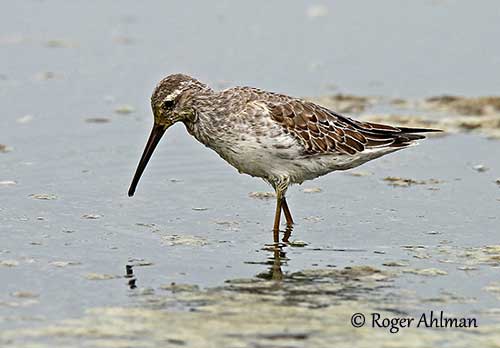
Fr: Bécasseau à échasses
Ang: Stilt Sandpiper
All Bindenstrandläufer:
Esp: Correlimos Zancolín
Ita: Piro piro zampelunghe
Nd: Steltstrandloper
Sd: styltsnäppa
Photographers:
Roger Ahlman
Pbase Galleries Peru and Ecuador & My bird pictures on IBC
Tom Grey
Tom Grey's Bird Pictures & Tom Grey's Bird Pictures 2
Jean-Claude Jamoulle
A la rencontre des Oiseaux
William Price
PBase-tereksandpiper & Flickr William Price
Alan & Ann Tate
AA Bird Photography
Text by Nicole Bouglouan
Sources:
HANDBOOK OF THE BIRDS OF THE WORLD Vol 3 by Josep del Hoyo-Andrew Elliott-Jordi Sargatal - Lynx Edicions - ISBN : 8487334202
SHOREBIRDS by Peter Hayman, John Marchant and Tony Prater – Christopher Helm – 1986 – ISBN: 0747014035
GUIDE DES LIMICOLES de D. Taylor - Delachaux et Niestlé - ISBN : 2603014080
All About Birds (Cornell Lab of Ornithology)
The Birds of North America online
Neotropical Birds – Cornell Lab of Ornithology
Bird Web (Seattle Audubon Society)
What Bird-The ultimate Bird Guide (Mitchell Waite)
Stilt Sandpiper
Calidris himantopus
Charadriiformes Order – Scolopacidae Family
INTRODUCTION:
The Stilt Sandpiper is a small shorebird very similar to other Calidris species. Its morphology, including long bill and legs and pointed wings is typical of this genus.
This gregarious wader is a long-distance migrant, breeding in extreme N North America and wintering in South America.
It feeds on aquatic invertebrates by probing in wet mud while slowly moving forwards. It is monogamous with long-term pair bonds. It nests on the ground on open tundra.
The Stilt Sandpiper is not globally threatened and the population is increasing in North America.
DESCRIPTION OF THE BIRD:
Biometrics:
Length: 18-23 cm
Wingspan: 38-47 cm
Weight: 42-100 g
The Stilt Sandpiper in breeding plumage has dark brown upperparts with rufous and whitish edges to feathers. Neck and upperbreast are streaked brown, whereas lower breast, flanks, belly and undertail-coverts are heavily barred.
We can see a conspicuous white supercilium, contrasting with chestnut lores, ear-coverts and nape. The crown is brown and rufous.
Male and female have similar plumage, but the female has slightly longer bill and wings.
The bill is laterally compressed, but the base is straight while the tip is down-curved and slightly laterally expanded. It is black, with sometimes greyish or brownish base. The eyes are dark brown. The long, slender legs and the partially webbed feet are yellowish-green.

The non-breeding adult has brownish-grey upperparts with white fringes to wing-coverts. The underparts are white with grey streaks on lower neck, breast and flanks. The white supercilium is still distinct.

The juvenile has dark brown upperparts with rufous to pale buff fringes. The wing-coverts are greyer with buff fringes. Foreneck and breast are streaked and slightly tinged buff. The belly is mostly white.
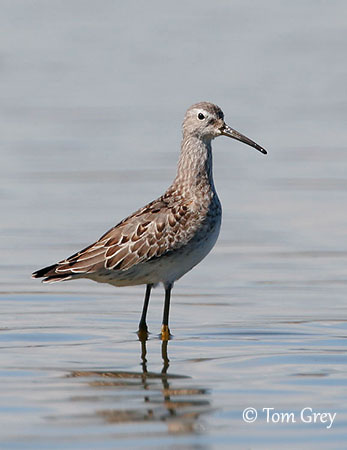
RANGE:
The Stilt Sandpiper breeds in N Alaska E to S Victoria Island, and W and S Hudson Bay.
It winters from S USA to South America, but mainly from Bolivia and SC Brazil to N Argentina (S to Buenos Aires).
HABITAT:
The Stilt Sandpiper breeds on tundra, usually in sedge meadows where it can find raised ridges near water for nesting-sites.
During winter, it can be seen in freshwater wetlands, flooded fields, shallow ponds and pools, marshes, but rarely along coast and intertidal mudflats.
Some observations mention this species up to 3,800 metres of elevation in the Andes of Ecuador.
CALLS AND SONGS: SOUNDS BY XENO-CANTO
The Stilt Sandpiper gives a soft rattling trill in flight “kirr” or “grrrt” and we can also hear a clearer “whu”.
During the aerial displays, it gives a complex series of guttural trills “tsurii tsurii tsurii” and also braying and whining sounds “hiiho hiiho hiiho”.
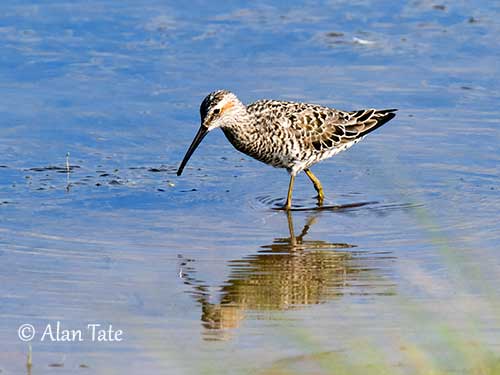
BEHAVIOUR IN THE WILD:
The Stilt Sandpiper feeds on various aquatic invertebrates such as insects (fly larvae, beetles and others), molluscs (marine worms and snails), and seeds, leaves and roots from aquatic vegetation.
It forages in shallow water, wading, probing and pecking with its long bill in wet mud, sometimes with submerged head, while moving slowly forwards. It may pick up insects from water surface too.
It is usually seen alone or in small groups, often associated with Lesser Yellowlegs and dowitchers of genus Limnodromus.

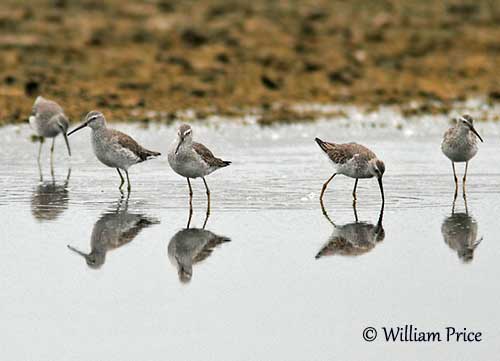
The Stilt Sandpiper male tends to arrive first on the breeding areas and the pair forms at nesting sites. They are territorial and monogamous with long-term pair bonds.
The male performs aerial displays over the territory, flying slowly with shallow wingbeats while calling. Then, it glides with the wings held in shallow V while uttering its guttural, complex song.
Chases are also performed in flight, with the male pursuing the female. Then, it plummets in front of her with the wings raised over the back and still singing.
The male makes several scrapes, but the final nest is chosen by the female.
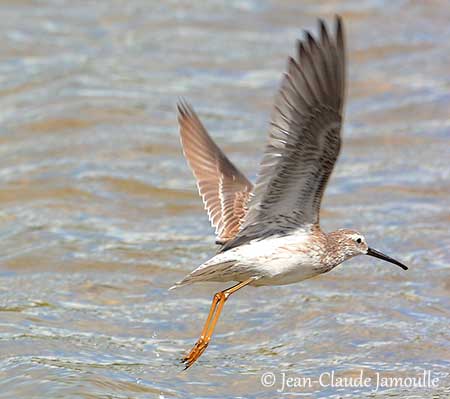
The Stilt Sandpiper is migratory and arrives at breeding grounds from late May. They leave the nesting areas from mid-July (adults) and mid-August (juveniles). Some non-breeders may remain in winter quarter all year round.
Vagrants are recorded in W and C Europe, as well to Azores, Morocco, Taiwan, Japan, Russian Far East, Australia and New Zealand.
The flight is strong and direct with powerful wingbeats.
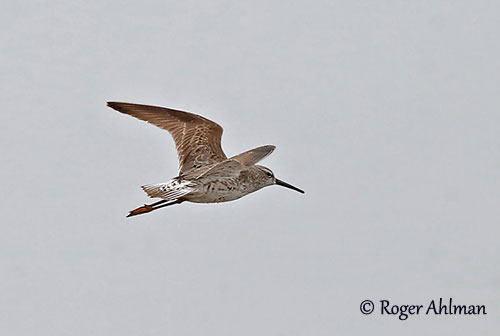
REPRODUCTION OF THIS SPECIES:
The nesting period occurs from June to August, with the laying between early June and mid-July.
The Stilt Sandpiper nests on top of sedge hummock or in dry spot on low gravel ridge, near water or on wet ground. It nests in dry open tundra.
The nest is an unlined scrape, or sometimes lined with willow leaves, moss, lichens and other materials found around the nest.
The female lays 3-5 creamy-white to olive green eggs with heavy brown dotting. Both adults share the incubation during 19-21 days. The female usually incubates at night and the male during the day.
The downy chicks leave the nest very soon after hatching and they are able to feed themselves. Both parents care them during the first days, but the female leaves the breeding range within a week and the male after 15 days. The juveniles can fly about 17-18 days after hatching.
PROTECTION / THREATS / STATUS:
The Stilt Sandpiper is not globally threatened and the population seems to be stable, in spite of local declines.
The species is currently evaluated as Least Concern.
